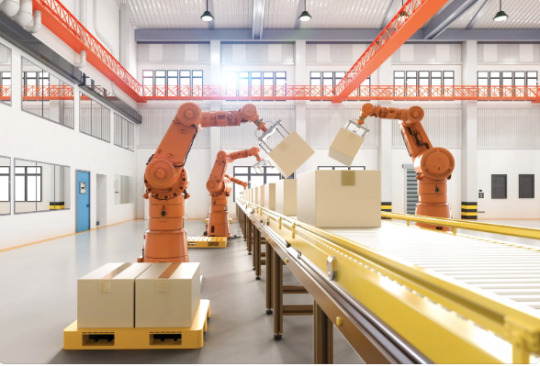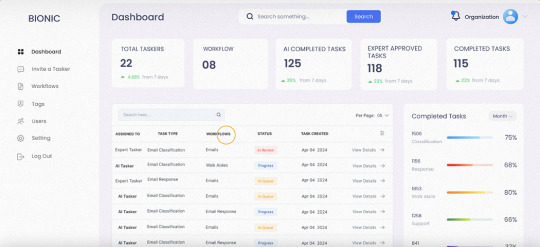#Enterprise automation
Explore tagged Tumblr posts
Text
🚀 Power Automate vs Azure Logic Apps – Which one to choose? Explore this in-depth comparison covering features, licensing, use cases, pros/cons, security, and more. A must-read for automation enthusiasts and IT decision-makers! #PowerAutomate #AzureLogicApps #Microsoft365 #Automation #LowCode #Azure
#Azure Integration#Azure Logic Apps#Cloud Automation#Enterprise Automation#Logic Apps vs Power Automate#Low Code#Microsoft 365#Power Automate#RPA#Workflow Automation
0 notes
Text
The Bold Shift: Why IT Leaders Must Champion Hyper-automation Now.
Sanjay Kumar Mohindroo Sanjay Kumar Mohindroo. skm.stayingalive.in Hyper-automation is not a tech upgrade—it’s a leadership challenge. Discover why bold IT leaders are driving the shift. Hyper-automation is no longer just a buzzword. It’s the lifeline for large enterprises that want to survive the next ten years. With rising operational costs, inconsistent manual processes, and growing…
#AI-driven automation#automation strategy#digital operations#digital transformation#enterprise automation#future of IT#hyper-automation#IT Leadership#low-code automation#modern IT stack#News#process automation at scale#RPA#Sanjay Kumar Mohindroo
0 notes
Text
What Are Agentic AI Systems and How Do They Work Autonomously?
Agentic AI systems are autonomous, self-directed technologies capable of decision-making without constant human input. Learn how they work. Agentic AI systems are transforming how machines interact with their environments by acting independently, adapting goals, and executing decisions. These systems use advanced machine learning to function autonomously, revolutionizing industries in the USA,…
0 notes
Text
Driving Business Agility Through Custom Enterprise Software Development
Why Custom Enterprise Software Is the Key to Agility In a fast-paced business world, agility isn’t optional—it’s survival. Off-the-shelf software can't always keep up with unique business demands. That’s where custom enterprise software steps in. From real-time insights to seamless integration and robust security, tailored solutions empower organizations to move faster and smarter.

Senrysa Technologies is leading this transformation—crafting scalable, intelligent systems for banks, government bodies, retailers, and more. The future? It’s all about AI-driven, adaptable enterprise tech that evolves as your business does.
#custom enterprise software#enterprise automation#enterprise mobility solutions#financial services technology#banking software development
0 notes
Text
Drive Productivity with Enterprise Automation Tools
LTIMindtree aligns automation strategies with business goals using fit-for-purpose models and scalable frameworks.
0 notes
Text
The Risks and Challenges of Hyperautomation: What Businesses Need to Know

To be in sync with the pace of developments around, hyperautomation is the new way adopted by organizations. It is generally integrated to automate redundant or repetitive tasks to avoid unnecessary expenses. It also makes the process efficient & faster. A business enterprise that has a customer-centric approach with a focus on operational excellence needs hyperautomation to save on time, effort, employee turnover, etc. It saves a lot of these aspects for organizations & gives better results.
Understanding Hyperautomation
Hyperautomation extends beyond traditional automation by leveraging AI-driven decision-making, real-time analytics, and interconnected systems to create a self-evolving digital ecosystem. Unlike standalone automation, smart automation requires businesses to integrate multiple technologies and rethink their operational strategies. While the benefits are evident, the journey toward enterprise automation is not without obstacles.
Key Risks and Challenges of Hyperautomation

1. Implementation Complexity
One of the biggest hurdles in adopting enterprise automation is its complexity. Businesses must integrate multiple technologies such as AI, ML, RPA, and process mining, which requires extensive planning, customization, and IT expertise. Many organizations struggle with aligning these technologies to their existing workflows, leading to costly delays and inefficiencies.
Solution: Companies should adopt a phased approach to hyperautomation, starting with smaller, high-impact automation projects before scaling. Investing in skilled IT professionals or partnering with specialized automation firms can also ease implementation challenges.
2. High Initial Costs and ROI Concerns
The upfront investment in hyperautomation can be substantial, involving software, infrastructure, and training costs. For startups and small businesses, the financial burden can be a significant deterrent. Additionally, businesses may not see immediate returns on investment (ROI), which can lead to hesitation in fully embracing enterprise automation.
Solution: Organizations must conduct a detailed cost-benefit analysis before implementation. Prioritizing use cases that deliver quick ROI can help build confidence in smart automation’s long-term benefits.
3. Workforce Displacement and Resistance to Change
The adoption of hyperautomation often leads to concerns about job displacement among employees. Many fear that AI-driven automation will replace human roles, leading to resistance and reduced morale.
Solution: Businesses should focus on workforce reskilling rather than replacement. By upskilling employees for higher-value tasks and promoting human-machine collaboration, organizations can create a balanced automation strategy that enhances productivity while preserving job security.
4. Cybersecurity and Data Privacy Risks
Cognitive automation relies heavily on data, AI, and interconnected systems, making businesses more vulnerable to cyber threats and data breaches. Automated processes, if not properly secured, can be exploited by cybercriminals, leading to significant financial and reputational damage.
Solution: Implementing robust cybersecurity protocols, regular audits, and AI-driven security measures can help mitigate risks. Organizations should also adhere to data protection regulations to ensure compliance and safeguard customer information.
5. Scalability Challenges
Scaling digital process automation across an enterprise requires careful planning. Many businesses struggle to expand automation initiatives beyond initial pilot projects due to integration issues, infrastructure limitations, or resistance from different business units.
Solution: Establishing a scalable framework from the outset can make expansion easier. Businesses should adopt modular automation solutions that can be seamlessly integrated and expanded as needed.
6. Process Standardization Issues
For hyperautomation to be effective, business processes need to be well-structured and standardized. However, many companies operate with fragmented workflows, making automation difficult to implement consistently.
Solution: Organizations should first optimize and standardize internal processes before introducing cognitive automation. Conducting process audits and leveraging process mining tools can help identify inefficiencies and create a more automation-ready environment.
7. Dependence on AI Decision-Making

While AI enhances automation by making intelligent decisions, over-reliance on AI-driven decision-making can pose risks. If algorithms are not properly trained or monitored, businesses may face errors, biases, or compliance issues.
Solution: Companies should adopt a hybrid approach where human oversight remains an integral part of automated decision-making. Regular AI model audits and ethical AI guidelines can help mitigate biases and ensure responsible automation practices.
8. Regulatory and Compliance Challenges
As enterprise automation evolves, regulatory frameworks struggle to keep up. Businesses must navigate industry-specific compliance requirements, data governance policies, and ethical considerations when implementing automation.
Solution: Staying informed about regulatory changes and collaborating with legal and compliance teams can ensure that automation initiatives align with industry standards. Businesses should also document and audit automated workflows to demonstrate compliance.
9. Lack of Clear Strategy and Vision
Many organizations jump into hyperautomation without a clear roadmap, leading to fragmented implementations and wasted resources. Without a well-defined strategy, businesses may automate redundant processes without achieving meaningful transformation.
Solution: Developing a strategic roadmap that aligns with business objectives is crucial. Leaders should set clear goals, measure progress, and ensure that enterprise automation initiatives contribute to long-term growth.
10. Vendor and Technology Dependency
Businesses often rely on third-party vendors for hyperautomation tools, leading to dependency on external providers. If a vendor discontinues support or changes pricing structures, companies may face operational disruptions.
Solution: Organizations should diversify their technology stack and maintain control over critical automation infrastructure. Open-source solutions and in-house automation capabilities can provide greater flexibility and reduce vendor-related risks.
The Path Forward: Navigating Hyperautomation Successfully

Key Takeaways for Business Leaders:
Adopt a phased approach – Start small, measure impact, and scale gradually.
Invest in talent and upskilling – Ensure employees are prepared for automation-driven roles.
Prioritize security and compliance – Implement strict cybersecurity measures and stay updated on regulations.
Balance AI with human oversight – Maintain human involvement in critical decision-making processes.
Develop a long-term strategy – Align automation goals with overall business objectives.
By taking a strategic and well-informed approach, businesses can harness the power of hyperautomation while mitigating potential risks. As technology advances, those who successfully navigate these challenges will gain a competitive edge in an increasingly automated world.
Uncover the latest trends and insights with our articles on Visionary Vogues
0 notes
Text
#enterprise automation#workload automation#automation software#IT Process Automation Software#Enterprise Automation Software
0 notes
Text
0 notes
Text
What is Enterprise Automation? A Comprehensive Guide for Beginners - Bionic

This Blog was Originally Published at:
What is Enterprise Automation? A Comprehensive Guide for Beginners — Bionic
Last month, our team experienced a breakthrough when we fully integrated enterprise automation into our daily operations. The change was palpable. Tasks that used to consume hours of our time were now completed in minutes.
One day, during a routine project update meeting, I noticed my colleague Sarah looking relieved. She shared how she had just completed a complex report that would have taken her days to finish manually.
Instead, the automation system had pulled the necessary data, generated the report, and even sent it to the stakeholders — all while she enjoyed her morning coffee.

It promised to streamline processes and free up my time for more strategic tasks. This guide will help you understand what is enterprise automation and how it can revolutionize your business operations.
What is Enterprise Automation?
Enterprise automation refers to using technology to automate business processes. It involves implementing systems and tools that handle repetitive tasks without human intervention.
In simple terms, it’s like setting up a virtual assembly line where tasks flow smoothly from one stage to the next. This allows employees to focus on more critical aspects of their jobs.
Enterprise automation can encompass various functions, including data entry, customer relationship management, and financial processes.

How Enterprise Automation Works
Let’s peel back the curtain and take a closer look at the key components that make this automation magic happen:
Robotic Process Automation (RPA): You can consider RPA as software robots (or “bots”) that mimic human actions on a computer. They can log into systems, copy and paste data, fill out forms, extract information from documents, and even make calculations. These bots are incredibly fast, accurate, and don’t need coffee breaks. They’re perfect for handling repetitive, rule-based tasks that can be done by using AI for business.
Business Process Management (BPM): BPM is like spring cleaning for your business processes. It involves analysing how work gets done, identifying bottlenecks or inefficiencies, and then designing improved workflows. Think of it as a map that guides your team through their tasks in the most efficient way possible. BPM tools often include features like process modeling, workflow automation, and performance monitoring, helping you continuously improve and optimize your operations.
Artificial Intelligence (AI) and Machine Learning (ML): This is where things get interesting. AI and ML are the brains behind intelligent automation. They enable systems to learn from data, make decisions, and even predict future trends. For example, an AI-powered chatbot can understand customer inquiries and provide instant, personalized responses. ML algorithms can analyze massive amounts of data to identify patterns and insights that humans might miss, helping you make better business decisions. The growth of AI in the last decade is miraculous too. According to a report, the global artificial intelligence market size is projected to expand at a compound annual growth rate (CAGR) of 37.3% from 2023 to 2030. It is projected to reach $1,811.8 billion by 2030.
Low-Code/No-Code Platforms: These platforms are like Lego blocks for building automation. You don’t need to be a tech wizard to create simple AI automation with these tools. They often have drag-and-drop interfaces, pre-built templates, and visual workflows, making it easy for non-technical users to design and deploy automation. This democratization of automation empowers your team to solve problems and automate tasks without relying solely on IT.

Key Areas Where Enterprise Automation Shall Be Executed
Data Management: Automating data entry and management tasks can significantly reduce errors and save time. Instead of manually entering customer information, artificial intelligence tools for business can extract data from forms and input it directly into the system.
Workflow Automation: This involves automating the flow of tasks within an organization. For example, approval processes can be streamlined by automatically routing documents to the appropriate stakeholders, ensuring that nothing gets lost in the shuffle.
Customer Relationship Management (CRM): Automating customer interactions, such as sending follow-up emails or scheduling appointments, can enhance the customer experience. This allows businesses to maintain consistent communication without the need for manual intervention.
Financial Processes: Automating invoicing, expense tracking, and payroll can reduce the administrative burden on finance teams. This not only speeds up processes but also ensures accuracy in financial reporting.
Human Resources: From onboarding new employees to managing performance reviews, HR processes can benefit greatly from automation. Automated systems can handle paperwork, track employee progress, and facilitate communication between HR and staff.
IT Management: Automating IT processes, such as software updates and system monitoring, can help organizations maintain their technology infrastructure with minimal downtime.

Benefits of Enterprise Automation
Increased Efficiency: By automating repetitive tasks, employees can focus on more strategic initiatives that drive business growth. This leads to a more productive workforce and faster project completion.
Cost Savings: While there may be an initial investment in automation tools, the long-term savings can be substantial. Reduced labor costs, fewer errors, and increased productivity all contribute to a healthier bottom line.
Improved Accuracy: Human error is inevitable, especially when dealing with repetitive tasks. Automation minimizes mistakes, ensuring that processes are executed consistently and accurately.
Scalability: As businesses grow, so do their operational demands. Automation allows organizations to scale their processes without the need for proportional increases in staff, making it easier to handle increased workloads.
Enhanced Customer Experience: With automation, AI and business can respond to customer inquiries more quickly and efficiently. This leads to higher customer satisfaction and loyalty, which are crucial for long-term success.
Better Compliance: Automated systems can help organizations adhere to industry regulations by maintaining accurate records and ensuring that processes are followed consistently.
Challenges and Considerations
While the benefits of enterprise automation are compelling, there are also challenges that organizations or any AI agency must navigate:
Initial Investment: Implementing automation solutions can require significant upfront costs, including software purchases and staff training.
Change Management: Employees may resist changes to established processes. It’s essential to communicate the benefits of automation and provide adequate training to ease the transition.
Integration Issues: Integrating new artificial intelligence tools for business with existing systems can be complex. Organizations must ensure that different software solutions can communicate effectively to avoid data silos.
Data Security: With increased automation comes the responsibility to protect sensitive data. Organizations must implement robust security measures to safeguard information from breaches.
Over-Reliance on Technology: While automation can enhance efficiency, organizations must strike a balance. Over-reliance on automated systems can lead to a lack of human oversight, which may be necessary for certain tasks.

Steps to Get Started with Enterprise Automation
Identify Pain Points: Begin by assessing your current processes to identify areas that are time-consuming or prone to errors. Engage with employees to gather insights on their challenges.
Define Goals: Clearly outline what you hope to achieve through automation. Whether it’s reducing costs, improving accuracy, or enhancing customer service, having specific goals will guide your implementation strategy.
Research Automation Tools: Explore various artificial intelligence tools for business that align with your goals. Consider factors such as ease of use, integration capabilities, and scalability when evaluating options.
Pilot Program: Before fully committing to an automation solution, consider running a pilot program. This allows you to test the effectiveness of the tool in a controlled environment and make necessary adjustments.
Train Your Team: Provide comprehensive training for employees who will be using the automation tools. This will help them feel more comfortable with the use of artificial intelligence for business and understand its benefits.
Monitor and Optimise: After implementation, continuously monitor the performance of your automated processes. Gather feedback from users and make adjustments as needed to optimize efficiency.
Consult an AI agency: Hiring an AI agency can help organizations implement AI solutions with all the expertise by outsourcing automation. Hiring an Artificial intelligence agency to implement Ai solutions can save on costs and efforts to develop an in-house AI automation team.
How Bionic can help you with Enterprise Automation?
Bionic is an innovative AI platform designed to streamline business processes by automating customer-facing interactions and handling repetitive tasks. It aims to enhance productivity and efficiency, allowing businesses to focus on more strategic initiatives.
Affordable and Trustworthy AI Solutions: Bionic offers a cost-effective approach to AI automation without compromising reliability. The platform combines advanced AI technology and grounding AI techniques with human oversight to ensure high-quality results. This dual approach minimizes the risk of errors often associated with AI, such as AI hallucinations or inappropriate responses.
Scalable and User-Friendly Workflows: The platform is designed to be easily configurable, allowing businesses or any artificial intelligence automation agency to set specific tasks and requirements according to their needs. Users can trigger tasks on demand, making it adaptable to varying workload demands. As Bionic’s AI capabilities improve over time, the cost of operations becomes cheaper, providing a scalable solution that grows with the business.
Human-in-the-Loop Approach: Bionic employs a unique human-in-the-loop model, where AI and human taskers collaborate to ensure quality and manage exceptions effectively. While the AI handles repetitive tasks, human oversight guarantees that the output meets the required standards. This synergy not only enhances productivity but also allows for quick adjustments during peak workloads or urgent task requirements.

Conclusion
Reflecting on my initial skepticism about enterprise automation, it’s clear that the potential for transformation is immense.
By embracing automation, organizations can streamline their operations, reduce costs, and empower their teams to focus on what truly matters.
As we move forward in an increasingly digital world, adopting enterprise automation is not just a trend; it’s a necessity for businesses looking to thrive.
So, if you find yourself bogged down by repetitive tasks, consider leaping enterprise automation. Bionic can completely assist you with that one. The journey may require effort and investment, but the rewards will undoubtedly reshape the way you work, allowing you to innovate and grow in ways you never thought possible.
0 notes
Text
gonna be enterprise posting for a while cuz im rewatching but ugh im reminded again how much it annoys me they utilize travis' backstory growing up on a cargo freighter what maybe once? twice? in the series run because i genuinely think its such a cool tidbit of human history in star trek. in the episode strange new world trip makes a joke at him saying "oh you cargo boomers are all the same" when travis says he couldn't imagine living planetside -- and theres a lot of these little comments and jokes especially early on that hint towards there being a whole culture that really predates starfleet of humans who live and work on cargo ships. ik star trek is allergic to stories about their world outside of starfleet and its not a coincidence that the only black character in the show got the backstory the showrunners claimed was too boring to actually explore in depth. but really its such a cool piece of history, esp considering travis makes references that not just his parents were boomers but seemingly his whole extended family and talks about certain experiences and language that point to it being a whole culture and almost a traveling diaspora of humans in space
#its cool! its interesting!!!!! and it totally shakes up the dynamic between the main human characters who all are very tied to#the physical space of earth whereas travis really doesnt have that allegiance#and also because i want to know more about labor in the star trek universe. i imagine a lot of that stuff is#automated by tng/ds9/voy era but cargo runners seemed to be a huge part of the earth economy up to and around the ent era#star trek#enterprise#txt
269 notes
·
View notes
Text


#bernie sanders#work week reduction#32-hour work week#overtime pay#productivity#technology#fair labor standards act#international examples#france#norway#denmark#germany#well-being#stress#fatigue#republican senator bill cassidy#small enterprises#job losses#consumer prices#japan#economic output#labor dynamics#artificial intelligence#automation#workforce composition
125 notes
·
View notes
Text
I'm sick, so I'm comfort-watching Voyager. I GOT sick because I crammed myself on four different flying sausage tubes over a period of three days so I could go to my son's graduation. I spent my flying sausage tube time reading Murderbot.
Now that you have context, let me just say: watching Voyager through a Murderbot lense is... something.
Tuvok. Janeway. Look me in the eye.
When one of your crew... one of your engineers, ffs... defects to a hostile nation...
YOU ROLL OVER YOUR FUCKING SECURITY CODES.
The Kazon come in firing and they're on the bridge like, "Wow, their weapons are going right through our shields, it's like they have our codes" YOU HAD AN ENGINEER DEFECT TO THE KAZON LAST WEEK ARE YOU TELLING ME YOU DIDN'T DO A SECURITY REVIEW FOR SYSTEM VULNERABILITIES OMGGGGGGGGGGGGG
Vulcans aren't actually any better at doing their own security than humans. Tuvok, SecUnit would be so mad at you.
#the murderbot diaries#star trek voyager#st:voy#This does remind me of that TNG episode 'Contagion'#where the Enterprise is infected by what is essentially an ancient virus#and I'm sitting there going 'I'm not a computer person but have you tried System Restore'#And then the solution was turning it off and turning it back on and I yelled at the screen bc it took them the full hour to try that#apparently living in fully automated luxury space socialism means forgetting the most basic aspects of security/computer troubleshooting
14 notes
·
View notes
Text
stop arguing the existence of forklifts in the atla comics under my post you guys. there was an honest to god truck in Day Of Black Sun
#atla#frankly I think the biggest technology jump engine/ locomotive wise between#atla and tlok would have been the transition from vehicles being owned by private#companies and the state -> individual citizens due to automation and changes to#RC infrastructure rather than the invention of the technology itself but thats another post.#LIKE IM JUST SAYING. the idea that the tech timeline in the avatar universe looks different than ours#because imperialism and the subsequent enterprises it spawned completely monopolized#the motor industry for a while before personal vehicles became popular and affordable could#be fun... play with me in this space... <- guy who is always saying this
64 notes
·
View notes
Text
Simplify Complexity with Smart Enterprise Application Development Services

In today's hyper-digital world, complexity is inevitable—but not unmanageable. That’s where Enterprise Application Development Services step in. Tailored for scalability, security, and integration, these solutions help businesses streamline operations, improve collaboration, and future-proof their digital infrastructure.
From automating redundant tasks to enabling real-time insights, smart enterprise apps are driving a new era of operational efficiency. Custom-built platforms can seamlessly connect departments, centralize data, and reduce manual dependencies, helping leadership make informed decisions faster.
Whether you’re in manufacturing, finance, retail, or logistics, enterprise-grade applications can be designed to fit your unique needs. With features like AI integration, cloud-based accessibility, and mobile responsiveness, modern enterprise software is no longer a luxury—it’s a necessity.
Partnering with the right development team can make all the difference. Look for a provider that emphasizes scalability, user-centric design, robust backend architecture, and ongoing support.
Ready to simplify complexity? Leverage enterprise application development services to build smarter systems and grow with confidence.
#Enterprise Application Development Services#enterprise automation#custom application development company#digital transformation in banking and finance#custom enterprise software development
0 notes
Text
Drive Productivity with Enterprise Automation Tools
LTIMindtree aligns automation strategies with business goals using fit-for-purpose models and scalable frameworks.
0 notes